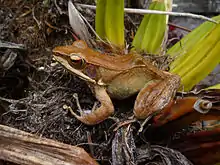| Floresian frog | |
|---|---|
 | |
| Scientific classification | |
| Domain: | Eukaryota |
| Kingdom: | Animalia |
| Phylum: | Chordata |
| Class: | Amphibia |
| Order: | Anura |
| Family: | Ranidae |
| Genus: | Papurana |
| Species: | P. florensis |
| Binomial name | |
| Papurana florensis (Boulenger, 1897) | |
| Synonyms[2] | |
| |
Papurana florensis is a species of true frog. It is native to the islands of Lombok, Sumbawa, and Flores in Indonesia.[1][2] Common names Floresian frog[1] and Flores frog have been coined for it.[2]
Taxonomy
Based on molecular data, the previously very diverse genus Hylarana was split in several genera, many of them previously treated as subgenera, in 2015. Molecular data from Papurana florensis was not included in the study, and therefore its placement in Papurana is provisional, pending more morphological and molecular data.[2][3]
Habitat and conservation
Papurana florensis is a lowland species that lives in wet areas of lowland dry forests and savannas, e.g., in marshes and streams. It is an uncommon species. Threats to it are unknown, as is its presence in protected areas.[1]
References
- 1 2 3 4 IUCN SSC Amphibian Specialist Group (2018). "Papurana florensis". IUCN Red List of Threatened Species. 2018: e.T58598A114923441. doi:10.2305/IUCN.UK.2018-1.RLTS.T58598A114923441.en. Retrieved 19 November 2021.
- 1 2 3 4 Frost, Darrel R. (2017). "Papurana florensis (Boulenger, 1897)". Amphibian Species of the World, an Online Reference. Version 6.0. American Museum of Natural History. Retrieved 23 September 2017.
- ↑ Oliver, Lauren A.; Prendini, Elizabeth; Kraus, Fred & Raxworthy, Christopher J. (2015). "Systematics and biogeography of the Hylarana frog (Anura: Ranidae) radiation across tropical Australasia, Southeast Asia, and Africa". Molecular Phylogenetics and Evolution. 90: 176–192. doi:10.1016/j.ympev.2015.05.001. PMID 25987527.
